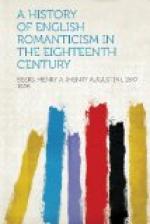Outside of Chaucer, and except among antiquarians and professional scholars, there was no remembrance of the whole corpus poetarum of the English Middle Age: none of the metrical romances, rhymed chronicles, saints’ legends, miracle plays, minstrel ballads, verse homilies, manuals of devotion, animal fables, courtly or popular allegories and love songs of the thirteenth, fourteenth, and fifteenth centuries. Nor was there any knowledge or care about the masterpieces of medieval literature in other languages than English; about such representative works as the “Nibelungenlied,” the “Chanson de Roland,” the “Roman de la Rose,” the “Parzival” of Wolfram von Eschenbach, the “Tristan” of Gottfried of Strasburg, the “Arme Heinrich” of Harmann von Aue, the chronicles of Villehardouin, Joinville, and Froissart, the “Morte Artus,” the “Dies Irae,” the lyrics of the troubadour Bernart de Ventadour, and of the minnesinger Walter von der Vogelweide, the Spanish Romancero, the poems of the Elder Edda, the romances of “Amis et Amile” and “Aucassin et Nicolete,” the writings of Villon, the “De Imitatione Christi” ascribed to Thomas a Kempis. Dante was a great name and fame, but he was virtually unread.
There is nothing strange about this; many of these things were still in manuscript and in unknown tongues, Old Norse, Old French, Middle High German, Middle English, Mediaeval Latin. It would be hazardous to assert that the general reader, or even the educated reader, of to-day has much more acquaintance with them at first hand than his ancestor of the eighteenth century; or much more acquaintance than he has with Aeschuylus, Thucydides, and Lucretius, at first hand. But it may be confidently asserted that he knows much more about them; that he thinks them worth knowing about; and that through modern, popular versions of them—through poems, historical romances, literary histories, essays and what not—he has in his mind’s eye a picture of the Middle Age, perhaps as definite and fascinating as the picture of classical antiquity. That he has so is owing to the romantic movement. For the significant circumstance about the attitude of the last century toward the whole medieval period was, not its ignorance, but its incuriosity. It did not want to hear anything about it.[2] Now and then, hints Pope, an antiquarian pedant, a university don, might affect an admiration for some obsolete author:




